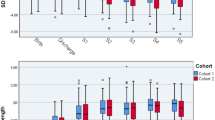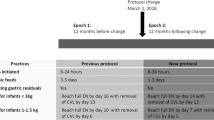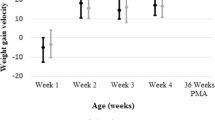Abstract
Limiting the number of days until achievement of full enteral feeding in extremely low birth weight neonates (ELBW; < 1000 g) might affect growth in the first years of life. This study compared the Z scores in growth over time of two cohorts of ELBW neonates that were comparable on maternal and neonatal characteristics and characteristics of hospitalization, but differed in enteral feeding strategy during neonatal admission. In the 2010–2014 cohort, full enteral feeding was achieved on average 16 days earlier than in the 2000–2005 cohort. In both cohorts, weight, height, and head circumference were recorded at birth and at the corrected ages of 9 and 24 months. A linear mixed model with repeated measures controlling for neonates small for gestational age showed no significant effect of different strategies in achievement of full enteral feeding on any anthropometric Z scores over time. Although full enteral feeding was achieved earlier in the 2010–2014 cohort, this was not associated with growth patterns during the first two years of life.
Conclusion: The effect of a change in strategy to achieve full enteral feeding at an earlier stage in ELBW neonates was assessed. Early enteral feeding strategies do not necessarily improve growth during the first two years of life.
What is Known: • Feeding strategies during neonatal stay may affect growth in the first years of life. • Strategies to achieve full enteral feeding earlier were implemented, but data on the impact on subsequent growth after discharge are limited. | |
What is New: • Full enteral feeding was achieved earlier, but this was not associated with improved growth during the first 2 years of life after discharge. • Early enteral feeding strategies do not necessarily improve growth during the first 2 years of life. |



Similar content being viewed by others
Notes
The Z score for head circumference on 24 months is lower for the included cases in cohort 2010–2014 (mean ± SD, − 0.97 ± 1.24 vs. − 2.33 ± 1.57, P = 0.034). However, only four of the non-included cases had valid measurements.
Abbreviations
- BPD:
-
Broncho-pulmonary dysplasia
- ELBW:
-
Extremely low birth weight
- GA:
-
Gestational age
- ICH:
-
Intra-cerebral hemorrhage
- LMM:
-
Linear mixed model
- NEC:
-
Necrotizing enterocolitis
- PREMATCH:
-
PREMATuritiy as predictor of Children’s cardiovascular and renal Health
- PPROM:
-
Premature preterm rupture of membranes
- ROP:
-
Retinopathy of prematurity
- SD(S):
-
Standard deviation (score)
- SGA:
-
Small for gestational age
- SIFT:
-
Speed of increasing milk feeds trial
References
Abbott J, Berrington J, Bowler U, Boyle E, Dorling J, Embleton N, Juszczak E, Leaf A, Linsell L, Johnson S, McCormick K, McGuire W, Roberts T, Stenson B (2017) The speed of increasing milk feeds: a randomised controlled trial. BMC Pediatr 17(1):39. https://doi.org/10.1186/s12887-017-0794-z
Blanco CL, Gong AK, Schoolfield J, Green BK, Daniels W, Liechty EA, Ramamurthy R (2012) Impact of early and high amino acid supplementation on ELBW infants at 2 years. J Pediatr Gastroenterol Nutr 54(5):601–607. https://doi.org/10.1097/MPG.0b013e31824887a0
Colacci M, Murthy K, DeRegnier RO, Khan JY, Robinson DT (2017) Growth and development in extremely low birth weight infants after the introduction of exclusive human milk feedings. Am J Perinatol 34(2):130–137. https://doi.org/10.1055/s-0036-1584520
Devlieger H, De Pourcq L, Casneuf A, Vanhole C, de Zegher F, Jaeken J, Eggermont E (1993) Standard two-compartment formulation for total parenteral nutrition in the neonatal intensive care unit: a fluid tolerance based system. Clin Nutr 12(5):282–286. https://doi.org/10.1016/0261-5614(93)90047-8
Dusick AM, Poindexter BB, Ehrenkranz RA, Lemons JA (2003) Growth failure in the preterm infant: can we catch up? Semin Perinatol 27(4):302–310. https://doi.org/10.1016/S0146-0005(03)00044-2
Euser AM, de Wit CC, Finken MJ, Rijken M, Wit JM (2008) Growth of preterm born children. Horm Res 70(6):319–328. https://doi.org/10.1159/000161862
Finken MJ, Dekker FW, de Zegher F, Wit JM (2006) Long-term height gain of prematurely born children with neonatal growth restraint: parallellism with the growth pattern of short children born small for gestational age. Pediatrics 118(2):640–643. https://doi.org/10.1542/peds.2006-0103
Goisbault M, Simon L, Hanf M, Darmaun D, Roze JC, Flamant C (2016) Neonatal length growth and height at two years. Neonatology 110(2):125–128. https://doi.org/10.1159/000444473
Hoaglin DC, Iglewicz B (1987) Fine-tuning some resistant rules for outlier labeling. J Am Stat Assoc 82(400):1147–1149. https://doi.org/10.1080/01621459.1987.10478551
Hoaglin DC, Iglewicz B, Tukey JW (1986) Performance of some resistant rules for outlier labeling. J Am Stat Assoc 81(396):991–999. https://doi.org/10.1080/01621459.1986.10478363
Karagol BS, Zenciroglu A, Okumus N, Polin RA (2013) Randomized controlled trial of slow vs rapid enteral feeding advancements on the clinical outcomes of preterm infants with birth weight 750–1250 g. JPEN J Parenter Enteral Nutr 37(2):223–228. https://doi.org/10.1177/0148607112449482
Keirse MJ, Hanssens M, Devlieger H (2009) Trends in preterm births in Flanders, Belgium, from 1991 to 2002. Paediatr Perinat Epidemiol 23(6):522–532. https://doi.org/10.1111/j.1365-3016.2009.01067.x
Mercuro G, Bassareo PP, Flore G, Fanos V, Dentamaro I, Scicchitano P, Laforgia N, Ciccone MM (2013) Prematurity and low weight at birth as new conditions predisposing to an increased cardiovascular risk. Eur J Prev Cardiol 20(2):357–367. https://doi.org/10.1177/2047487312437058
Ohnishi S, Ichiba H, Tanaka Y, Harada S, Matsumura H, Kan A, Asada Y, Shintaku H (2016) Early and intensive nutritional strategy combining parenteral and enteral feeding promotes neurodevelopment and growth at 18 months of corrected age and 3 years of age in extremely low birth weight infants. Early Hum Dev 100:35–41. https://doi.org/10.1016/j.earlhumdev.2016.03.014
Ong KK, Ahmed ML, Emmett PM, Preece MA, Dunger DB (2000) Association between postnatal catch-up growth and obesity in childhood: prospective cohort study. BMJ 320(7240):967–971. https://doi.org/10.1136/bmj.320.7240.967
Raaijmakers A, Petit T, Gu Y, Zhang Z, Wei F, Cools B, Jacobs L, Thijs L, Thewissen L, Levtchenko E, Staessen JA, Allegaert K (2015) Design and feasibility of “PREMATurity as predictor of children’s Cardiovascular-renal Health” (PREMATCH): a pilot study. Blood Press 24(5):275–283. https://doi.org/10.3109/08037051.2015.1053220
Raaijmakers A, Jacobs L, Rayyan M, van Tienoven TP, Ortibus E, Levtchenko E, Staessen JA, Allegaert K (2017) Catch-up growth in the first two years of life in extremely low birth weight (ELBW) infants is associated with lower body fat in young adolescence. PLoS One 12(3):e0173349. https://doi.org/10.1371/journal.pone.0173349
Roberts G, Cheong J, Opie G, Carse E, Davis N, Duff J, Lee KJ, Doyle L (2013) Growth of extremely preterm survivors from birth to 18 years of age compared with term controls. Pediatrics 131(2):e439–e445. https://doi.org/10.1542/peds.2012-1135
Roelants M, Hauspie R, Hoppenbrouwers K (2009) References for growth and pubertal development from birth to 21 years in Flanders, Belgium. Ann Hum Biol 36(6):680–694. https://doi.org/10.3109/03014460903049074
Seigel JK, Smith PB, Ashley PL, Cotten CM, Herbert CC, King BA, Maynor AR, Neill S, Wynn J, Bidegain M (2013) Early administration of oropharyngeal colostrum to extremely low birth weight infants. Breastfeed Med 8(6):491–495. https://doi.org/10.1089/bfm.2013.0025
Stutte S, Gohlke B, Peiler A, Schreiner F, Born M, Bartmann P, Woelfle J (2017) Impact of early nutrition on body composition in children aged 9.5 years born with extremely low birth weight. Nutrients 9(2). https://doi.org/10.3390/nu9020124
Abbott J, Berrington JE, Boyle E, Dorling JS, Embleton NE, Juszczak E, Leaf AA, Linsell L, Johnson S, McCormick K, McGuire W, Roberts T, Stenson B (2013) Early enteral feeding strategies for very preterm infants: current evidence from Cochrane reviews. Arch Dis Child Fetal Neonatal Ed 98(6):F470–F472. https://doi.org/10.1136/archdischild-2012-303260
Funding
This study was supported by the “Agency for Innovation, Science, and Technology in Flanders (IWT) through the “SAFEPEDRUG” project (IWT/SBO 120033).
Author information
Authors and Affiliations
Contributions
K.A. and A.R. designed the study. C.B. and A.R. collected data. T.P.v.T. analysed the data, C.B.,T.P.v.T, and A.R. interpreted the data and drafted the article. M.R. and K.A. provided critical revision or the paper. All authors approved the final version of the manuscript.
Corresponding author
Ethics declarations
Conflicts of interest
The authors declare that there are no conflicts of interest.
Ethical approval/informed consent
The study was conducted in accordance with the Helsinki declaration for investigations in human subjects. The local Ethics Committee of the University Hospitals Leuven (Belgium) approved the study protocol. Parents gave informed consent prior to the PREMATCH studies.
Additional information
Communicated by Mario Bianchetti
Electronic supplementary material
ESM 1
(DOCX 25 kb)
Rights and permissions
About this article
Cite this article
Brants, C., van Tienoven, T.P., Rayyan, M. et al. Earlier achievement of full enteral feeding in extremely low birth weight neonates is not associated with growth improvement in the first 2 years of life. Eur J Pediatr 177, 1247–1254 (2018). https://doi.org/10.1007/s00431-018-3178-y
Received:
Revised:
Accepted:
Published:
Issue Date:
DOI: https://doi.org/10.1007/s00431-018-3178-y




